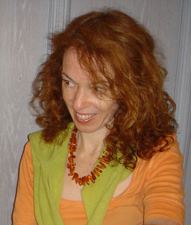Name Hava Siegelmann | Role Computer scientist | |
 | ||
Thesis Foundations of Recurrent Neural Networks (1993) Education Technion – Israel Institute of Technology Books Neural networks and analog computation Fields Computer Science, Neuroscience, Systems biology, Biomedical engineering | ||
Lifelong learning machines (L2M) - Hava Siegelmann keynote at HLAI
Hava Siegelmann is a professor of computer science, and a world leader in the fields of Artificial Intelligence, Machine Learning, and Computational Neuroscience. Her academic position is in the school of Computer Science and the Program of Neuroscience and Behavior at the University of Massachusetts Amherst; she is the director of the school's Biologically Inspired Neural and Dynamical Systems Lab.
Contents
- Lifelong learning machines L2M Hava Siegelmann keynote at HLAI
- Artificial Intelligence Colloquium Lifelong and Robust Machine Learning
- Biography
- Papers
- Partial List of Applications
- Books
- References
Artificial Intelligence Colloquium: Lifelong and Robust Machine Learning
Biography
Siegelmann is an American computer scientist who founded the field of super-Turing computation. For her lifetime contribution to the field of Neural Networks she is the recipient of the 2016 Donald Hebb Award. She earned her PhD at Rutgers University, New Jersey, in 1993.
In the early 1990s, she and Eduardo D. Sontag proposed a new computational model, the Artificial Recurrent Neural Network (ARNN), which has been of both practical and mathematical interest. They proved mathematically that ARNNs have well-defined computational powers that extend the classical Universal Turing machine. Her initial publications on the computational power of Neural Networks culminated in a single-authored paper in Science and her monograph, "Neural Networks and Analog Computation: Beyond the Turing Limit".
In her Science paper, Siegelmann demonstrates how chaotic systems (that cannot be described by Turing computation) are now described by the Super-Turing model. This is significant since many biological systems not describable by standard means (e.g., heart, brain) can be described as a chaotic system and can now be modeled mathematically.
The theory of Super-Turing computation has attracted attention in physics, biology, and medicine. Siegelmann is also an originator of the Support Vector Clustering http://www.scholarpedia.org/article/Support_vector_clustering, a widely used algorithm in industry, for big data analytics, together with Vladimir Vapnik and colleagues. Siegelmann also introduced a new notion in the field of Dynamical Diseases, "the dynamical health" , which describes diseases in the terminology and analysis of dynamical system theory, meaning that in treating disorders, it is too limiting to seek only to repair primary causes of the disorder; any method of returning system dynamics to the balanced range, even under physiological challenges (e.g., by repairing the primary source, activating secondary pathways, or inserting specialized signaling), can ameliorate the system and be extremely beneficial to healing. Employing this new concept, she revealed the source of disturbance during shift work and travel leading to jet-lag and is currently studying human memory and cancer in this light.
Siegelmann has been active throughout her career in advancing and supporting minorities and women in the fields of Computer Science and Engineering. Through her career Siegelmann consulted with numerous companies, and has received a reputation for her practical problem solving capabilities. She is on the governing board of the International Neural Networks Society, and an editor in the Frontiers on Computational Neuroscience.
Papers
Partial List of Applications
Books
She has also contributed 21 book chapters.
